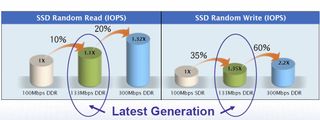How Do SSDs Redefine Storage Performance?
It only takes one or two modern SSDs to outperform business-class RAID arrays with four or eight hard drives. We're running a full comparison and looking at the implications for high-performance systems when you make the transition to flash-based tech.
SSD Developments
When discussing SSD performance, it’s important to define what performance actually means. The term is either used to measure speed or to look at metrics like power consumption, efficiency, or performance per watt. In the storage segment, capacity per dollar or per watt can be key metrics, while top-performance systems, particularly in enterprises, can benefit from high I/O performance per watt.
Consumers will look at throughput numbers first, which range anywhere from 180 to more than 300 MB/s for sequential read operations and 80 to 300 MB/s for writes. Most products are limited by the SATA 3Gb/s interface to less than 300 MB/s peak performance, but even the few drives available with 6 Gb/s interfaces aren’t always the best choice, since their I/O performance doesn’t scale with interface bandwidth. All the horsepower in the world doesn’t matter if you’re stuck at an intersection.
Most SSDs are based on multi-channel architectures that combine various flash memory lines to maximize performance. Because of this, increasing interface bandwidth might not always be necessary. The only item left to improve is the flash memory itself.
What’s Driving Flash Memory Growth?

As you can see from Samsung’s data, SSDs are getting close to roughly 10% share in NAND flash memory utilization. The projection shows SSD becoming almost 20% of the NAND flash market by 2012. The only other segment that should see even larger growth is ultramobile devices, such as tablets and smartphones.
Performance: Next Steps

What does this mean in terms of performance? The chart above is also from a Samsung presentation, but it’s representative of what double data rate (DDR) NAND flash can do compared to conventional SDR flash products. Samsung states a 10% to 35% increase in I/O performance thanks to this technology tweak. Keep in mind that you will not see more throughput, but the number of individual transactions could increase.
Stay On the Cutting Edge: Get the Tom's Hardware Newsletter
Get Tom's Hardware's best news and in-depth reviews, straight to your inbox.

Current page: SSD Developments
Prev Page The Business Storage Revolution Next Page The SSD: Samsung 470-Series (MZ-SPA256, 256 GB)Most Popular

